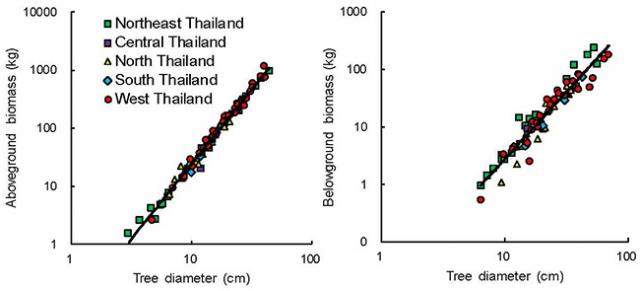Home > Research > Research Results > Research Results 2019 > Development of a universal formula to estimate the biomass of teak forests in Thailand
Update:December 25, 2019
Main content starts here.
Development of a universal formula to estimate the biomass of teak forests in Thailand
| Article title |
General estimation models for above- and below-ground biomass of teak (Tectona grandis) plantations in Thailand |
|---|---|
| Author (affiliation) |
Tanaka Kenzo(a), Woraphun Himmapan (b), Reiji Yoneda (c)(d), Narin Tedsorn (b), Tosporn Vacharangkura (b), Gaku Hitsuma (c), Iwao Noda (c)(e) (a) Department of Plant Ecology, FFPRI, Tsukuba, Ibaraki, Japan. (b) Forestry Research and Development Bureau, Royal Forest Department, Bangkok, Thailand. (c) Forestry Division, Japan International Research Center for Agricultural Sciences, Tsukuba, Ibaraki, Japan. (d) Shikoku Research Center, FFPRI, Kochi, Japan. (e) Center for International Partnerships and Research on Climate Change, FFPRI, Tsukuba, Ibaraki, Japan. |
| Publication Journal |
Forest Ecology and Management Volume 457, 1 February 2020, 11770142(5):219-229 DOI:10.1016/j.foreco.2019.117701( External link ) |
| Content introduction |
Teak (Tectona grandis) is native to tropical Asia and is grown in Thailand, Myanmar, and some other countries. Because of its excellent timber quality and rapid growth, teak is planted in Central and South America and tropical Africa as well as in Asia. Teak is an important source of wood; in addition, teak plantations serve as carbon sinks. To evaluate this function, it is necessary to estimate the biomass (weight) of trees growing in a forest. In Thailand, which has the second largest teak forests in the world, estimation formulas for the above-ground biomass have been developed for only limited regions, and virtually no data are available to develop estimation formulas for below-ground biomass. In this study, we cut or dug out teak trees in 18 locations across Thailand and investigated relationships between the diameter and height of trees and weight measurements of trunks, branches, leaves, and roots to develop a formula to estimate the biomass. Interestingly, biomass quantities could be estimated using one universal formula because virtually no differences were observed among regional above- and below-ground biomass estimation formulas. Moreover, the below-ground biomass could be estimated from the forest age and the above-ground biomass. The use of these estimation formulas improves the preciseness of biomass estimation for teak forests across Thailand and allows the accurate evaluation of carbon storage in these plantations.
Figure 1. All-teak Vimanmek Mansion Palace (left), trunk weight measurement (upper right), and root digging (lower right). Teak trees have long been used as materials for luxury furniture and for building houses. In the past, teak was in great demand for ship decks, and the deck of the Titanic was also made of teak. The Vimanmek Mansion Palace, which was built in Thailand in 1902, is the world’s largest building made of teak. In this study, we cut teak trees in different sizes and weighed their leaves, trunks, and branches separately. In addition, the roots were dug using heavy machinery or human labor, and were carefully collected and weighed.
Figure 2. Relationships between the above-ground (left) or below-ground (right) biomass and teak trunk diameters. One universal formula could be used to estimate the biomass of teak forests in various regions of Thailand. |
Copyright © Forest Research and Management Organization. All rights reserved.


